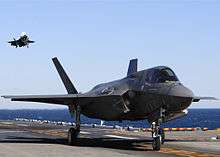Shipborne rolling vertical landing
Shipborne rolling vertical landing (SRVL) is a method used to land a V/STOL aircraft that uses both the vertical thrust from the jet engine and lift from the wings.
A V/STOL aircraft normally either lands vertically or it makes a conventional runway landing. For a vertical landing it uses downward thrust from the lift fan and/or rotated jet nozzle(s), while for a runway landing the jet nozzle(s) are pointed rearward. With a rolling vertical landing the aircraft uses downward jet thrust to hover while it is still moving fast enough to also generate wing lift. This allows for a rolling landing with a significantly reduced approach speed and landing distance.
With an SRVL manoeuvre, a V/STOL aircraft can make a rolling landing on an aircraft carrier and come to an effective stop with the disc brakes in the landing gear. Unlike a conventional rolling landing on a carrier, this does not require the use of an arrestor wire and tailhook. The operational advantage of this technique is that it can increase the landing payload capacity of a V/STOL aircraft, which can be restricted when it lands vertically. It can also reduce the level of wear on the lift engines and extend their operational life. Similarly, it can reduce the amount of wear upon the deck surface of a carrier caused by the downward jet exhaust from vertical landings.
History
Harrier
.jpg)
An SRVL development program was undertaken with the Harrier by the UK defence manufacturer, Qinetiq.[1] In 2007 the company used their Vectored-thrust Aircraft Advanced Control (VAAC) Harrier test aircraft to demonstrate the feasibility of the landing technique on the French navy carrier Charles de Gaulle.[2] A series of landing approach trials were also flown with the Royal Navy carrier HMS Illustrious in 2008. The carrier was fitted with a visual landing aid called a “Bedford Array”, which provides glidepath information to the pilot through a helmet-mounted display.
V-22
In October 2015, NAVAIR tested rolling landings and takeoffs with the Bell Boeing V-22 Osprey tiltrotor on a carrier, preparing for Carrier onboard delivery.[3]
F-35B

SRVL landing is under development for use with the F-35B.[4] The aircraft will operate in the STOVL mode on the first of the new Queen Elizabeth class aircraft carriers. Rolling landings will enable the F-35B to land on these carriers with an increased weapon and fuel load and will use the aircraft's computer controlled disc brakes. On the weekend of 13/14 October 2018, the Royal Navy announced that British test pilot Peter Wilson made history when he conducted the first-ever shipborne rolling vertical landing (SRVL) in an F-35B (test aircraft BF-04) onto HMS Queen Elizabeth.[5] Her sister ship, HMS Prince of Wales, is equipped with the full 'Bedford Array' Visual Landing Aid system. By taking inputs from inertial references to stabilise against deck motions, combined with a ship-referenced velocity vector in a helmet-mounted display, a pilot can fly an accurate approach to the deck on a constant glidepath.
References
- "Qinetiq-led team demonstrates carrier landing system for JSF". flightglobal.com. Retrieved 10 June 2012.
- "VAAC Harrier 2007 - World's First SRVL (Shipborne Rolling Vertical Landing)". Jet Art Aviation Ltd. 12 December 2019. Retrieved 12 December 2019.
- Tony Osborne (12 November 2015). "V-22 Osprey Testing Could Lead To Higher Takeoff Weights". Aviation Week.
- "Lockheed gets funds for UK F-35 landing modification". flightglobal.com. Retrieved 10 June 2012.
- "F-35 pilot makes history with revolutionary method of landing jets on HMS Queen Elizabeth". Royal Navy. 15 October 2018. Retrieved 15 October 2018.